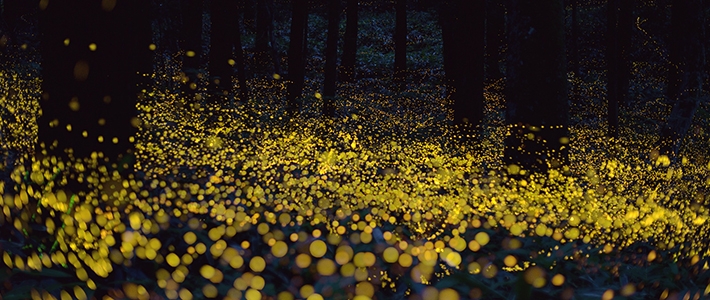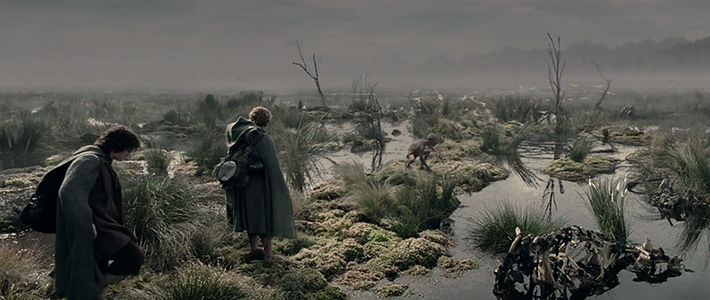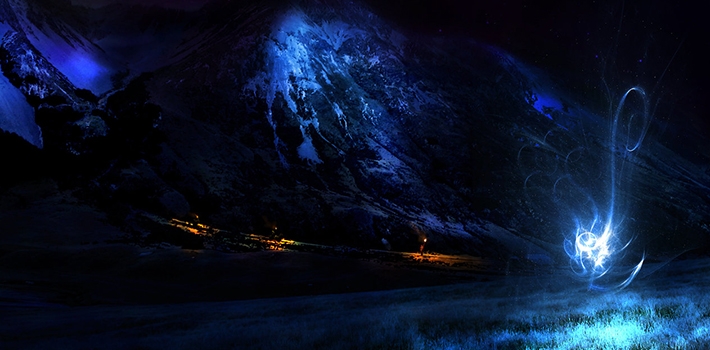Ghostly lights witnessed only in the dead of night around swamps and marshes are the type of sight that would naturally prompt supernatural or magical explanations, especially in a time before science could give a reasonable explanation for such phenomenon. Common interpretations have cited them as the lamps of fairies or goblins attempting to lure night travellers from their path. The lights may be dismissed as the product of an over-active imagination, but so many eyewitness accounts give strength to the belief that they have genuinely been sighted and have an origin, whether or not that origin be supernatural. The Will-o'-the-wisp is a prevalent feature in the folklore of many cultures, though it goes by many different names and its appearances have been read as both benevolent and misleading, sometimes downright hostile. It has gained a foothold in literature, and has also been used in a metaphorical context. Some of the beliefs surrounding the Will-o'-the-wisp seem to be driven purely by the imagination, however, investigation into the possible scientific explanations of such a phenomenon may suggest reasons why these details became such a crucial part of the fairy tales.
An invitation to fairy world or a lure into danger?
Eyewitness accounts of Will-o'-the-wisp note the lights receding when approached, thereby drawing those who follow them away from the beaten track. The folklore of some cultures believes that this is a benevolent act, and an honour reserved for a select few. Some say that the lucky person who sees the lights and follows them will be treated to the sight of fairies in celebration. Scandinavian folklore promises treasure at the end of the lights, supposedly marking the location at which valuable goods are buried deep underground or water. However, the fairies responsible Will-o'-the-wisp in European folklore are either spirits of the dead or mischievous fairies attempting to lead people astray. In Welsh tales, the light is 'fairy fire' that is carried by a pwca, a small goblin who leads travellers away from the path at night. When they are led sufficiently far from the familiar route, the light is extinguished and the traveller is lost. South American legend tells a far more threatening story of the Boi-tatá, a fiery serpent that leaves its cave after a flood to prey on animals and corpses at night. It eats only the eyes of its victims, and the collective light from the consumed eyes gives the beast its fiery gaze. The Will-o'-the-wisp is also referred to as 'ignis fatuus,' which is Latin for 'foolish fire,' in support of the stories that feature these lights as the products of mischievous fairies attempting to tease humans and lure them into trouble.
Has science dispelled the myth?
Like many strange occurrences that have gained mythological explanations, science has attempted to rule out supernatural causes by finding an explanation for these ghostly lights. Bioluminescence could be the cause, as some living organisms that live in and around swamps, for example, fireflies or honey fungus, produce and emit light. Though bioluminescent plants would not move in the way the eyewitness accounts recall, fireflies would dance like fairy lamps and would retreat upon sensing a disturbance in the air from the approach of humans. Alternatively, birds in flight over swampy areas, barn owls for example, may reflect the light of the moon off their plumage, creating the appearance of ghostly moving lights in the dark.

Long-exposure photographs of fireflies in the Chugoku region of Japan.
Credit: Tsuneaki Hiramatsu
The most commonly accepted explanation for Will-o'-the-wisp involves organic decay and the spontaneous combustion of the gases that are produced. Normally, decomposition occurs in the presence of plenty of oxygen, and so produces largely water, carbon dioxide and heat. However, in swampy areas where there is more water and less oxygen, anaerobic bacteria break the matter down instead, producing methane, carbon dioxide, nitrogen and phosphines. Phosphines and methane are both flammable and burst into flame in the presence of air, and especially if the air is particularly charged, by lightning for example. When they undergo combustion they emit photons, producing coloured light. This explanation suits well the tales that note of lights retreating when approached, because the gases would disperse when there is a disturbance in the air caused by a person approaching.
Tolkien seems to make reference to Will-o'-the-wisp in 'The Lord of the Rings,' as Frodo and Sam are crossing the Dead Marshes on their way to Mordor. Gollum tells them not to "follow the lights," otherwise they will keep the company of the dead and will end up lighting candles of their own. This seems to follow in the tradition of European folklore, which often cites the lights as being lit by spirits of the dead attempting to lead the living astray. In Peter Jackson's film adaptation of the novels, we see corpses of the dead armies lying beneath the water. Though a supernatural explanation is implied in the film and the novels, it seems to acknowledge organic decay as an explanation for the lights over the water. These corpses, lying beneath the water in low-oxygen conditions, would certainly be undergoing anaerobic decomposition and would produce quantities of methane and phosphines that may combust to produce the blue lights.

The Dead Marshes.
Credit: New Line Cinema
However, attempts to replicate ignis fatuus under laboratory conditions (mixing crude phosphine and natural gas) by British geologist Alan A Mills in 1980 resulted in a green light and a lot of acrid smoke. This was quite unlike eyewitness accounts of the phenomenon, as they suggested clear blue lights with no smoke. Mills therefore suggested that Will-o'-the-wisp could be caused instead by a Cool Flame. This is a non-vigorous reaction produced in a reaction combining fuel and air. It releases a little heat, light and carbon dioxide, and so would produce a more delicate and less smoky effect than witnessed in his experiments.
An alternative explanation involves the Piezoelectric effect. Piezoelectricity is a charge that accumulates in certain solid materials as a response to applied mechanical stress. If the rocks below a swamp or marsh contained minerals with piezoelectric qualities, like quartz, silicon or arsenic, they may experience a build of electric charge when put under pressure from the weight of the soil or the water above. The electricity may get channelled up through the soil and the swamp water, resulting in lights that appear electric and erratic, and certainly more of the supernatural quality suggested by the eyewitness reports. Noting how Scandinavian folklore refers to ignis fatuus marking the location of buried treasure, it is easy to believe that people investigating the site on which they witnessed these strange lights could find piezoelectric minerals below the ground and consider them hidden treasure. Quartz was often used in Europe to make jewellery. Similar piezoelectric minerals may also have appeared like beautiful and precious treasure.
Before knowledge of the piezoelectric effect, finders of the treasure would not have made the same conclusion to link the sparkling, valuable crystals they had found and the blue dancing lights apparently advertising their location. Considering this interpretation of Will-o'-the-wisp originates in Scandinavia, it could suggest a cultural willingness to accept the supernatural as benevolent, or it could be the result of their finding such minerals at the site of the ghostly lights. Perhaps there are greater deposits of piezoelectric minerals beneath swamps in Scandinavia than in other parts of the world? Perhaps they were the nation curious enough to look and find 'treasure'? (I've searched for information about the prevalence of quartz deposits worldwide, to no avail. If you're able to enlighten me on the subject, I'd love to hear from you.)
'Foolish Fire'
The Will-o'-the-wisp makes an appearance near the start of Bram Stoker's 'Dracula,' witnessed by Jonathan Harker as he is being driven to the Count's Castle at night. The driver is in fact the Count himself, though in disguise, and he leaves the vehicle to follow the light, described as "a faint flickering blue flame." The following night, Jonathan asks the Count about the blue flames and is told that it is a common folkloric belief that on a certain night of the year evil spirits supposedly have unchecked power. Upon this night, a blue flame may be sighted, which is believed to indicate where treasure has been concealed. The Count, disguised as the driver, had attempted to mark the location of the treasure by gathering piles of stones where he sighted the blue flame. This belief in Will-o'-the-wisp marking the location of buried treasure is similar to what is true in Scandinavian folklore.
Stoker also uses the "Will-o'-the-wisp" in a metaphorical sense, as Dr Seward later notes in his diary: "Transcendentalism is a beacon to the angels, even if it be a Will-o'-the-wisp to man." The Will-o-the-wisp represents a thing that is tempting, or gives hope and promise, but is actually impossible to reach. Similarly, Satan of Milton's 'Paradise Lost' is compared to a Will-o'-the-wisp as he tempts Eve to take the fruit of the tree of knowledge. Satan's encouragements are only revealed as misleading when Eve takes the fruit and realises that the promise was hollow. She had been led astray by Satan's promises.

Credit: Tim Verkerk / DeviantArt
Forgive me another reference to Tolkien's 'The Lord of the Rings.' When Gandalf is leading the fellowship through the mines of Moria, his wizard's light is described as "bobbing like a will-o'-the-wisp in front of them." Tolkien appears here to be using the folkloric trope as both a way of describing the appearance of the wizard's staff and also to heighten the tension by drawing upon connotations from folklore. It could be a sign that he is leading them astray, along dangerous paths and away from the path they should be treading. Or perhaps noting that he's leading them towards the deeply hidden treasure uncovered by the dwarves of Moria. In European and Welsh folklore, the fairy fire is carried by a mischievous magical character, a fairy or a goblin, so Tolkien may be suggesting that Gandalf is a little more mischievous or misleading than we may otherwise believe. A Will-o'-the-wisp is a person or thing who cannot be depended upon, a flickering beacon that goes out when it is most needed. As he apparently leads the fellowship to a place of danger, it would be fair to say that Gandalf is not wholly a trustworthy character.
Reports of Will-o'-the-wisp have declined, probably as a result of the draining of swamplands and marshes in recent centuries. However, if you happen to see blue lights dancing over marshland at night, you may wish to contemplate the scientific explanations that may lie behind the phenomenon. Or you may prefer to ignore the science, and imagine the lights as the work of fairies. Follow them if you dare.
References & Further Reading
- Milton, "Paradise Lost", Samuel Simmons (1667).
- Stoker, "Dracula", Archibald Constable & Company (1897).
- Tolkien, "The Lord of the Rings", George Allen & Unwin (1954 - 1955).
Listing image: Walt Disney Pictures
